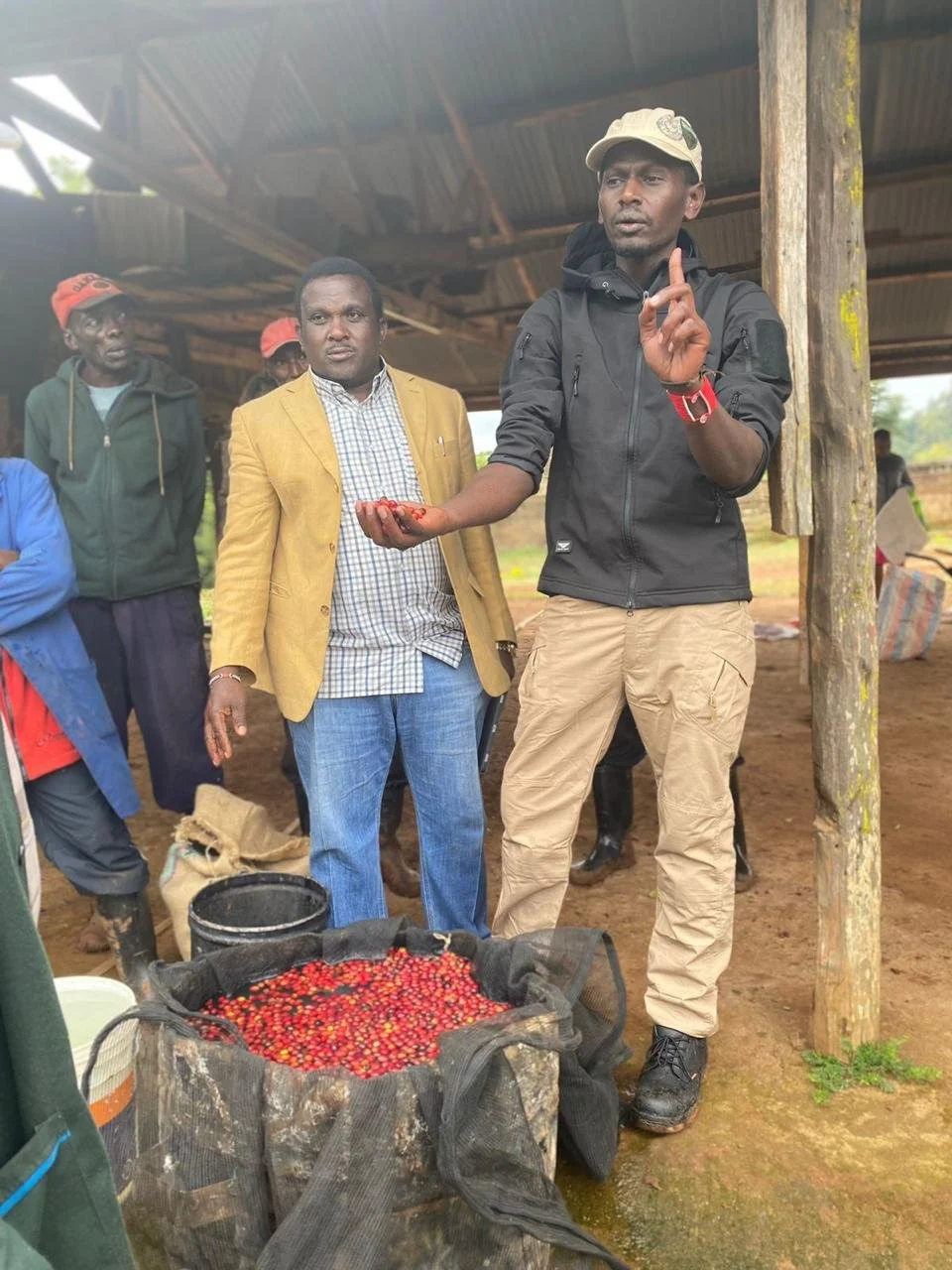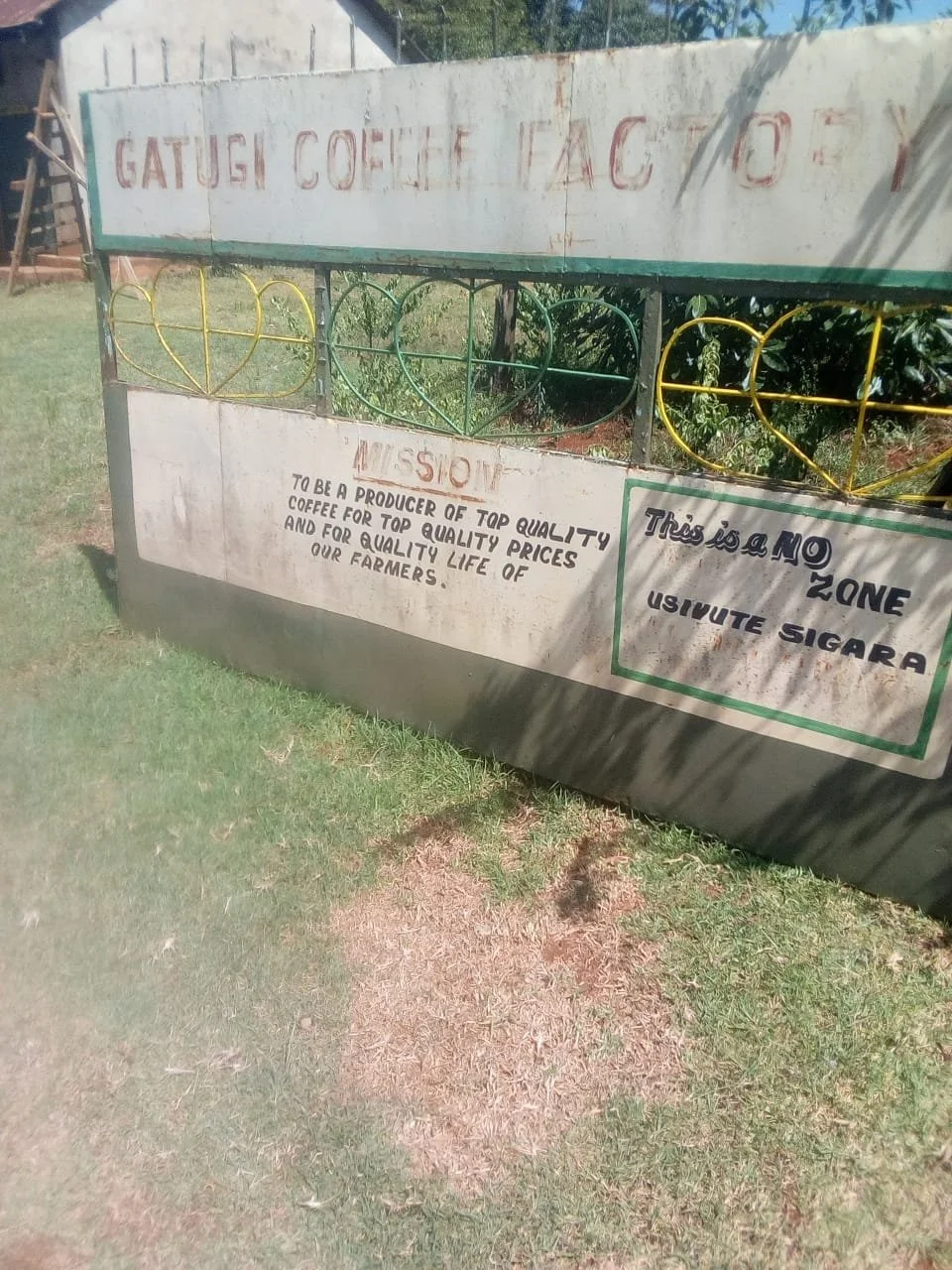Kamathura AB washed Top LOT
KAMATHURA AB WASHED
Harvest: 2024
Producers: Kamavindi Coffee Lab in collaboration with Smallholders from Thiriku & Ichamama
Bag Size: 60 KG
Region: Central Nyeri
Altitude: 1600 - 1800 MASL
Variety: SL-28, SL-34, Riuru 11
Grade: AB (Top Lot)
Harvest Method: Manually Picked
Process: Washed
Drying Time: Sun Dried on Raised Beds For 14 - 21 Days
SUMMARY
Peter Mbature took over management of the Kamavindi Coffee Estate after the passing of Martin Mbature in 2018 and his mother Helen Weveti in 2021. Peter's wife Gladys Mwaniki, sister Gladwell Wanjira and her husband Chilumo Ringa have since taken Kamavindi to the next level. Together they built and opened Kamavindi Coffee, and Mbature Trading exports in 2024.
The original idea behind Kamathura comes from the idea that many producers in Kenya don't trust the supply chains in place, but unfortunately also dont have direct access to buyers. This often leads to coffee going to less than optimal sales channels and fetching lower prices than the coffee truly deserves. Kamavindi Coffee Lab for years has been slowly forging relationships and trust with other small estates and cooperative societies throughout Kenya so that they can work with producers to advise on quality practices, but also help taste through the coffees to give good feedback. Coffees that taste great and meet tight physical specifications- Kamavindi Coffee Lab can help link to specialty buyers. Kamathura is a blend of some the the best coffees that Kamavindi comes across. The goal of Kamathura is to be a place for producers to get better value than traditional channels, and for roasters to have a staple Kenyan coffee that is an approachable flavor profile than you often find in Kenya.
This lot was sourced from both Thiriku smallholders and smallholders of the Ichamama washing stations. The Ichamama station is situated between two rivers: The Rwarai and The Chinga River that both originate and cascade down from The Aberdare Mountain Ranges. The coffees sourced and delivered to the sites are renowned as some of the best coffees in all of Kenya, and that is a very heavy acknowledgement considering how much amazing coffee there is in Kenya. Ichamama is one of the largest collection sites and washing stations in Nyeri. It collects cherries from approximately 925 registered smallholder members (256 women/669 men) with an average of 0.5 acre of land dedicated to growing coffee. Their total coffee production for this year's coffee harvest totaled 443,000 kg of coffee cherries. The washing station is very well organized and the farmers are improving their agricultural practices to improve yields. Another notable contribution by the smallholders of Ichamama is their contribution and dedication to planting a broader diversity of tree planting (Bananas and Macadamia) along the coffee bushes to enhance agroforestry in the area.
The Thiriku Station is located in the Tetu constituency within Nyeri County. Abandoned coffee drying beds paint a dull picture of what coffee farming used to be at one time in this area. Poor payment, corruption by the management officials in the cooperatives, and decreasing productivity have been cited as the cause of the misfortunes that have swamped the coffee industry in Kenya.
In steps Peter Mbature and Kamavindi Coffee Lab. The name Kamathura come from the fact that this coffee is put together by Kamavindi Coffee Lab (Kama) and that in the Kiembu languague the name for a selection is "Thura." So Kamathura means a Kamavindi (Top) Selection.
Why is Kamathura different than just any regional blend? Because Kamavindi Coffee Lab is different. A third generation coffee producer, Peter Mbature started out on a mission to learn how to improve his familys coffee and improve the lives of his fellow producers. In the very beginning, he got started by talking to some of the best coffee roasters he could find in the world. Peter forged relationships with these top roasters and talked nearly every week to them about coffee quality and production. Peter then started learning to taste coffee himself, and within a short few years Peter became one of the first small estate growers in the entire country to earn his Q coffee cupping certification. However Kamavindi is not just a solo operation. Peter and much of his family and extended family have joined forces to manage the coffee estate and run the quality control and purchasing lab that sources some of the best coffees Kenya has to offer.
VARIETIES
SL-28
SL28 is among the most well-known and well-regarded varieties of Africa. It has consequently spread from Kenya, where it was originally selected in the 1930s, to other parts of Africa (it is important in Arabica-growing regions of Uganda, in particular) and now to Latin America. The variety is suited for medium to high altitudes and shows resistance to drought, but is susceptible to the major diseases of coffee. SL28 is notable for its rusticity—a quality meaning that it can be left untended for years or even decades at a time, and then return to successful production. There are SL28 trees in many parts of Kenya that are 60-80 years old and still productive. SL28 was selected at the former Scott Agricultural Laboratories (now the National Agricultural Laboratories, NARL situated at Kabete—more information below). Individual tree selections made at the Scott Laboratories during the 1935-1939 period were prefixed SL. Fourty-two trees of various origins were selected and studied for yield, quality, and drought and disease resistance. SL28 was selected in 1935 from a single tree in a population called Tanganyika Drought Resistant. In 1931, the senior coffee officer of Scott Labs, A.D. Trench, conducted a tour of Tanganyika (now Tanzania). According to historical documents, he noticed a variety growing in the Moduli district that appeared to be tolerant to drought, diseases and pests. Seed was collected and brought back to Scott Laboratories, where its drought resistance was confirmed. It was widely distributed until superseded by its progeny, SL28. SL28 was considered the prize selection of this period of intensive breeding. Recent genetic tests have confirmed that SL28 is related to the Bourbon genetic group. History of Scott Agricultural LaboratoriesScott Agricultural Laboratories (now the National Agricultural Laboratories, NARL) was established by the colonial British government in Kenya in 1922. It conducted agricultural research and provided technical advice and training to Kenyan farmers on behalf of the Department of Agriculture. Scott Agricultural Labs employed an entomologist, a mycologist, and a plant breeder. The Coffee Section, previously housed in a central office of the department, was moved to the laboratories in 1934 and had twenty-four acres dedicated to coffee. The name of the unit was derived from the history of its buildings. Constructed in 1913 as a sanatorium and used during the First World War as a war hospital, the buildings were named for Dr. Henry Scott, a missionary from the Church of Scotland. When the Department of Agriculture took over the buildings in 1922, they named them the Scott Agricultural Laboratories. Both Scott Agricultural Laboratories in Kenya and Lyamungo Research Station in Tanganyika became the main centers for coffee breeding in East Africa. Research was conducted at the lab and in cooperation with private estate owners. A history of the labs states: “The trial of imported varieties is a conspicuous feature of the work at the Laboratories…. Selections from individual trees showing desirable characteristics are being grown.” Other coffee work included comparative yield trials, grafting experiments, and effects of pruning, shade trials, and cover crops, among others. In 1944, Kenya decided to move coffee research to a dedicated coffee research station with better facilities for field experiments; Jacaranda Estates (20 miles north of Ruiru) with 380 acres. It became operational in 1949. Substations were also established in Upper Kiambu in 1957, Meru in 1958, Kitale in 1938, Lake Victoria in 1959, and Kisii in 1957.
SL-34
SL34 was originally selected in Kenya the late 1930s at the Scott Agricultural Laboratories. Individual tree selections made at the Scott Laboratories in Kenya during the 1935-1939 period were prefixed “SL.” SL34 was selected from a single tree on the Loresho Estate in Kabete, Kenya since research at the Scott Laboratories was often conducted in cooperation with local, private estate owners. The tree was labeled “French Mission.” French missionaries known as Spiritans established a mission in 1893 at Bura (Taita Hills, Kenya), in which Bourbon coffee seeds originating from La Réunion island were planted. The seedlings from Bura were brought to another French Mission in Saint Austin (near Nairobi) in 1899, and from there seeds were distributed to settlers willing to grow coffee. This is the origin of so-called French Mission coffee.Because of the historical movement of coffee seeds directly from La Réunion via the French missionaries, French Mission is widely understood to be another name for Bourbon. However, recent genetic tests have indicated that SL34 is related to the Typica genetic group. It is possible that the original story about SL34 being selected from a French Mission population could be incorrect.
RUIRU 11
Ruiru 11 is a compact, high yielding variety developed in Kenya to allow for more intensive coffee production with fewer losses from diseases and pests. Ruiru 11 owes its existence to a coffee berry disease (CBD) epidemic in 1968 that lead to the loss of 50% of Kenya’s production. The crisis sparked action. In the 1970s, the coffee research station at Ruiru, which gives Ruiru 11 its name, began an intensive breeding program for varieties that were immune to CBD. This led to the development of Ruiru 11, which was released in 1985. Breeders were focused on creating a compact variety suited to intensive planting, but one that had the high cup quality characteristic of the tall varieties predominant in Africa. Breeders spend many years crossing multiple progenitors to create what breeders call a complex hybrid that would gather the best attributes each of the chosen progenitors. This work resulted in the creation the male parent of Ruiru. The chosen progenitors of Ruiru 11’s complex hybrid male parent conferred resistance to CBD (coming from Rume Sudan, Timor Hybrid lines, and K7) and good cup quality (coming from N39, SL28, SL34 and Bourbon).










